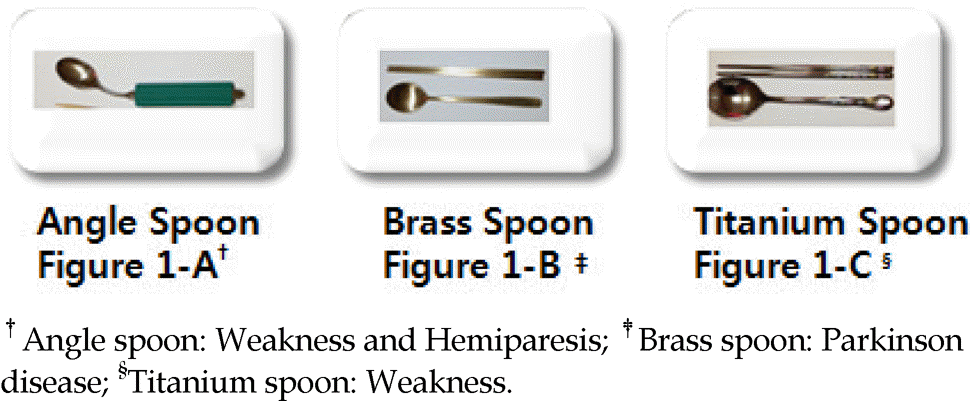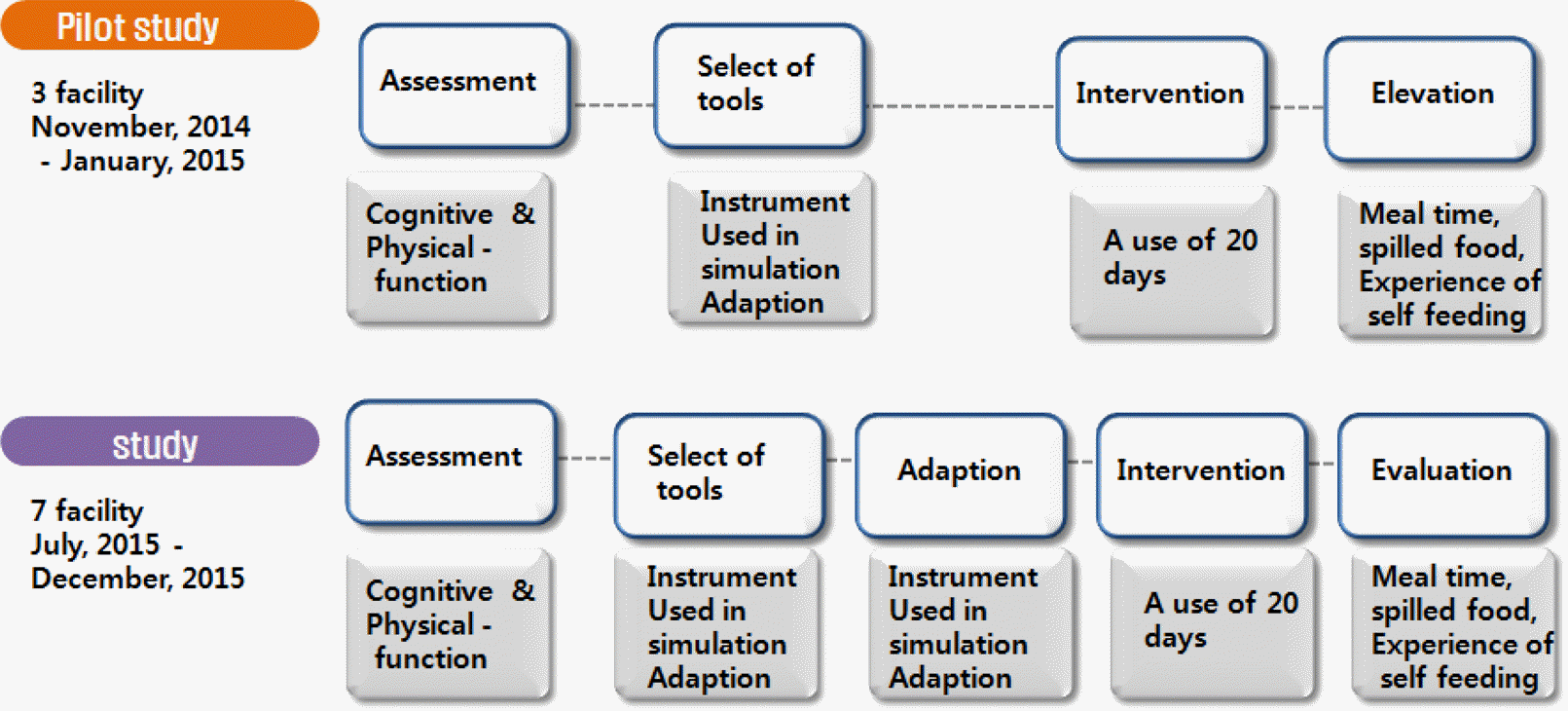Abstract
Purpose
This study aims to investigate the effects of an intervention of self-feeding for elderly residents who were eating with assistance or eating by himself/herself with spilling food.
Methods
The Participants were 11 elderly people and 6 formal caregivers from 7 nursing homes in Korea. The intervention was to use the spoon and chopstick sets designed for compensating the weakened eating function. Both quantitative and qualitative data were collected through observation, structured questions, and in-depth interviews.
Results
The mealtime was significantly increased by 3.2 minutes (p=.011) after the intervention. Three themes were extracted for the meaning of self-feeding expressed by the elders; fighting alone for self-feeding, pride of participating in the study, and burden for self-feeding and research participation. Caregivers expressed the meaning of the elder’s self-feeding such as the regret of missed chances, facilitating rehabilitation, the increase of the eating pleasure and quality of care, and ambivalence.
Go to : 
References
1. Statistics Korea. 2017 Statistics of senior citizens [Internet]. Seoul: Statistic korea;2017. [cited 2017 September 26]. Available from: Portal/korea/kor_nw/2/6/1/index.board.
2. Ministry of Health and Welfare. 2017 Guidelines for healthcare health services I.II. [Internet]. Seoul: Ministry of Health and welfare;2017. [cited 2017 January]. Available from: www.nohw.go.kr.
3. Speroff BA, Davis KH, Dehr KL, Larkins KN. The dining experience in nursing homes. North Carolina Medical Journal. 2005; 66(4):292–295.

4. Kim JH, Kang SN, Lee, KH. Meal services at long-term care facilities in Kyung-In Area. The Journal of Korean Academic Society of Home Care Nursing. 2015; 22(1):47–58.
5. Oh JJ. Assisting demented patients with feeding in nursing homes. Journal of the Korean Gerontological Society. 2006; 26(2):315–328.
6. Chang CC, Roberts BL. Cultural perspectives in feeding difficulty in Taiwanese elderlywith dementia. Journal of Nursing Scholarship. 2008; 40(3):235–240. https://doi.org/10.1111/j.1547-5069.2008.00231.x.
7. Rogers JC, Snow T. An assessment of the feeding behaviors of the institutionalized elderly. The American Journal of Occupational Therapy. 1982; 36(6):375–380. https://doi.org/10.5014/ajot.36.6.375.

8. Sandman PO, Norberg A, Adolfsson R, Eriksson S, Nyström L. Prevalence and characteristics of persons with dependency on feeding at institutions for the elderly. Scandinavian Journal of Caring Sciences. 1990; 4(3):121–127. https://doi.org/10.1111/j.1471-6712.1990.tb00058.x.
9. Center for Medicare and Medicaid Services. 2013. Nursing home data compendium [Internet]. USA: Center for Medicare and Medicaid Services;[cited 2014 Jun 20]. Available from:. https://www.cms.gov/Medicare/Provider-Enrollment-and-Certification/CertificationandComplianc/downloads/nursinghomedatacompendium_508.pdf.
10. Baltes MM, Zerbe MB. Reestablishing self-feeding in a nursing home resident. Nursing Research. 1976; 25(1):24–26. https://doi.org/10.1097/00006199-197601000-00007.

11. Ott F, Readman T, Backman C. Mealtimes of the institutionalized elderly: A literature review. Journal of Occupational Therapy. 1990; 57(5):261–267. https://doi.org/10.1177/000841749005700505.

12. Park KY, Kin MS. The Satisfaction and the need of assistive devices for the elderly. Korea Aging Friendly Industry Association. 2009; 1(1):31–38.
13. Manning AM, Means JG. A self feeding program for geriatric patients in a skilled nursing facility. Journal of the American Dietetic Association. 1975; 66(3):275–276.
14. Barnes S, Mauk KL. Long term care. Lubkin IM, Larsen , editors. Chronic illness: impact and intervention. 8th ed. Burlington: Jones Bartlett Learning;2013. p. 561–59.
15. Lim JS, Choi JS, Lee MH. The movement toward resident-centered care in long-term care facilities: A Contingency theory view. The Journal of the Korean Gerontological Society. 2012; 32(1):25–49.
16. Cho KJ, Han DH. Study on food habits of the elderly in institution. Journal of the Korean Society of Food Science and Nutrition. 1998; 27(4):756–764.
17. Kim DJ, Son SS, Lee NH, Cho HM. Market analysis of assistive products for elders. Korea Institute for Health and Social Affairs. Research Report. Seoul: Ministry of Health and Welfare;2012. December. Reort No.: 2012-47-19.
18. Dukes S. Phenomenological methodology in the human sciences. Journal of Religion and Health. 1984; 23(3):197–203. https://doi.org/10.1007/BF00990785.

19. Bandura A. Social learning theory. New Jersey: Prentice-Hall;1977. p. 246.
20. Braun V, Clarke V. Using thematic analysis in psychology. Qualitative Research in Psychology. 2006; 3(2):77–101. https://doi.org/10.1191/1478088706qp063oa.

21. Yen PK. Impact of the eating environment. Journal of Geriatric Nursing. 2003; 24(4):255–256. https://doi.org/10.1016/s0197-4572(03)00206-4.

22. Tomas DR, Ashmen W, Morley JE, Evans WJ. Nutritional management in long-term Care: Development of a clinical guideline. The Journal of Gerontology: Series A. 2000; 55(12):M725–M734. https://doi.org/10.1093/gerona/55.12.M725.
23. Pierson C. Ethnomethodologic analysis of accounts of feeding demented residents in long-term care. Journal of Nursing Scholarship. 1999; 31(2):127–131. https://doi.org/10.1111/j.1547-5069.1999.tb00447.x.

24. Lee KH. Meaning of a meal among nursing home elderly and staff. Journal of the Korean Gerontological Society. 2016; 36(4):1157–1176.
25. Lee MH. Independence of institutionalized elderly women: Ethnomethodological approach. Journal of Qualitative Research. 2002; 3(1):27–40. http://www.dbpia.co.kr/Article/NODE01538536.
26. Bonnel WB. Managing mealtime in the independent group dining room: An educational program for nurse's aides: An educational program helps nurse's aids understand that eating is a task for many elders. Geriatric Nursing. 1995; 16(1):28–32. https://doi.org/10.1016/s0197-4572(05)80076-x.
27. Ronch JL. Changing institutional culture: Can we re-value the nursing home? Journal of Gerontological Social Work. 2004; 43(1):61–82. https://doi.org/10.1300/j083v43n01_06.
28. Daly M. Care as a good for social policy. Journal of Social Policy. 2002; 31(2):251–270. https://doi.org/10.1017/s0047279401006572.

Go to : 




 PDF
PDF ePub
ePub Citation
Citation Print
Print




 XML Download
XML Download